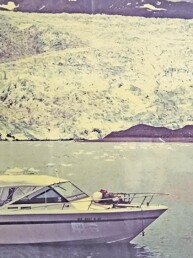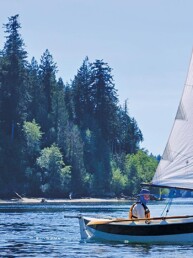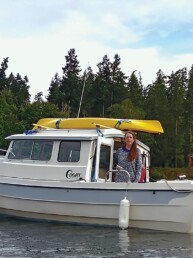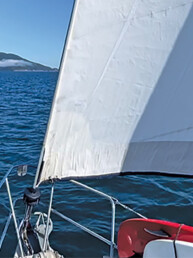
Gather around your glowing screen, dear reader, it’s time for some sea stories. For the Yahtzee crew, this particular yarn starts in the small fishing town of Craig, Alaska and ends some 1,300-miles and 10-days later in the bustling port of San Francisco, California.
A lot of you may be wondering why we chose to jump offshore all the way from Southeast Alaska to San Francisco instead of taking the conventional route down the Inside Passage through British Columbia before heading out. Deciding to go offshore hinged on a few key factors, the most significant of which was weather, and our thinking went like this:
- By going inside, we’d most likely be spending many days, weeks and miles under power slogging south. Not fun.
- Our crew doesn’t take conservative or well-worn routes just because that’s how it’s typically done. Not our style.
- We wanted to sail offshore to the west coast of Vancouver Island, but, alas, there are no points of entry anymore. Not cool, Canada.
- After spending several gorgeous weeks motoring around windless Southeast Alaska, maximizing time under sail was a big priority. Fun.
Taking all of that into consideration, Jill and I talked through our options over an evening brewski and when I said, “How about we just sail to San Francisco.” She quickly replied. “Yes!” And with that, we watched the weather and waited for the right window to open up. When a consistent westerly and northwesterly pattern established itself on the ocean, we stocked Yahtzee with food in Craig, topped up our fuel and water, put the boat in offshore mode, and made a course south for California knowing full well that there were going to be some serious highlights and lowlights along the way. Fortunately, the highs outnumbered the lows, and the stories go like this…
Highlight – Getting our sea legs
Motoring over a glass calm sea out of Southeast Alaska, the open ocean and long horizon in front of us is calling. Once clear of Baker Island, the wind promptly fills in from the west and with a hoot and holler from the crew, Yahtzee leans to port and off we sail. Up and down the wind goes over the next 24 hours and on and off goes the engine. But on day two, the breeze steadies and keeps coming. Completely out of site of land, we settle in on a starboard tack and let the wind do its thing. Bounding south in a 25-knot westerly, Yahtzee turns into a rocket ship downwind and we tick off three consecutive 160-mile days past British Columbia. All the while, dolphins play on the bow, the stars and sunsets and rises put on daily shows, and the deep blue of the open ocean captivates our senses.
As for the crew, with the wind comes larger seas and a 10-plus-foot swell, and we all take a couple days to get our sea legs and stomachs right, and to find our patterns in sleeping and watch keeping. Our onboard routines are flowing seamlessly by now, though, with Jill and I alternating 3 hour shifts at night and napping during the day. And, as expected, the boys overcome mild cases of mal de mer by day three with a combination of rest, fluids and a little bit of food.
We know that making fast and comfortable offshore passages means being prepared and confident in what the weather is going to serve up along the way, and we were happy to have good information coming to us from my brother Matt and friends Ryan Helling and Mike Descheemaeker. Over those first few days, our spot-on forecasts of westerly and northwesterly winds allowed for exactly what we’d hoped for, a ton of amazing sailing — until that one day…
Lowlight (literally) – The weather gets messy
With Yahtzee’s staysail set and two reefs in the main, water washes over the deck while battling a southerly wind that has gone from 10 to 15 to 30 knots in the matter of a few hours. The seas, too, have jumped in height and are now like big rolling hills that we climb over and then down again. Rinse and repeat. Saltwater starts finding its way in through the deck into any tiny nook and cranny possible, and several waves sweep under the dodger and down the companionway.
In the moment, we know this struggle is just the beginning, but the edge of the low will also pass relatively quickly. Onward we push throughout the day and into the night, fighting an unforgiving and unrelenting sea. All the while, the crew remains steady, upbeat and undeterred. Then, just before sunset, I watch as a line of clouds approaches from the northwest. “That’s it! That will bring the new wind!” and we tack to head west into the teeth of it. Sure enough, by midnight the now 40-knot breeze is abating and by 2 am the once strong southerly has turned into a moderate westerly. We’ve made it out the other side and are relieved to know it will be all downwind from there.
When we left Alaska, I knew the potential for skirting the edge of this low about 150-miles off the Washington-Oregon coast was very likely. No matter how good an offshore forecast is, it’s exceedingly difficult to make any 10-day passage without at least a day or two of adverse weather. Having encountered and sailed in similar storm conditions at sea before, I was also well aware that we’d be fine. We’d just need to make the sails small and keep the boat moving until it passed over us. In end, that’s what we did, and it was never unsafe, just uncomfortable.
Highlight – Big wind and seas means lots of sailing
Sitting in the cockpit facing aft, I watch as monster waves roll in from behind us, pick up our stern and then launch Yahtzee forward with plumes of white water shooting off each side. My smile seems as wide as the horizon. With the low past us now and high pressure bringing bright blue skies and 30-knots of northerly wind, we’re having the ride of our lives. And the boys love being in the cockpit, watching the swell roll underneath us and the boat surf.
Andy Cross
Andy Cross is the editor of 48° North. After years cruising the Pacific Northwest and Alaska with his family aboard their Grand Soleil 39, Yahtzee, they sailed south and are currently in the Caribbean Sea. You can follow their adventures at SailingYahtzee.com.






